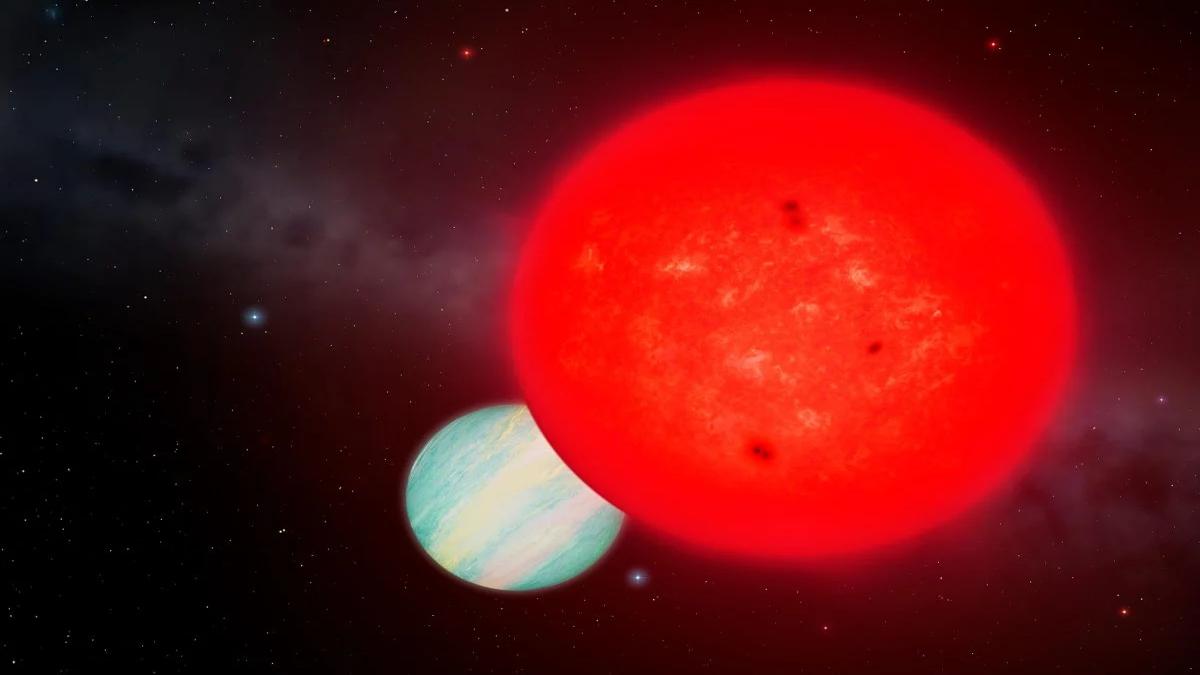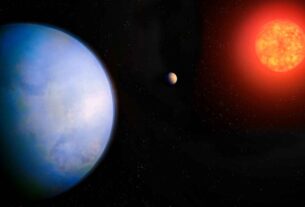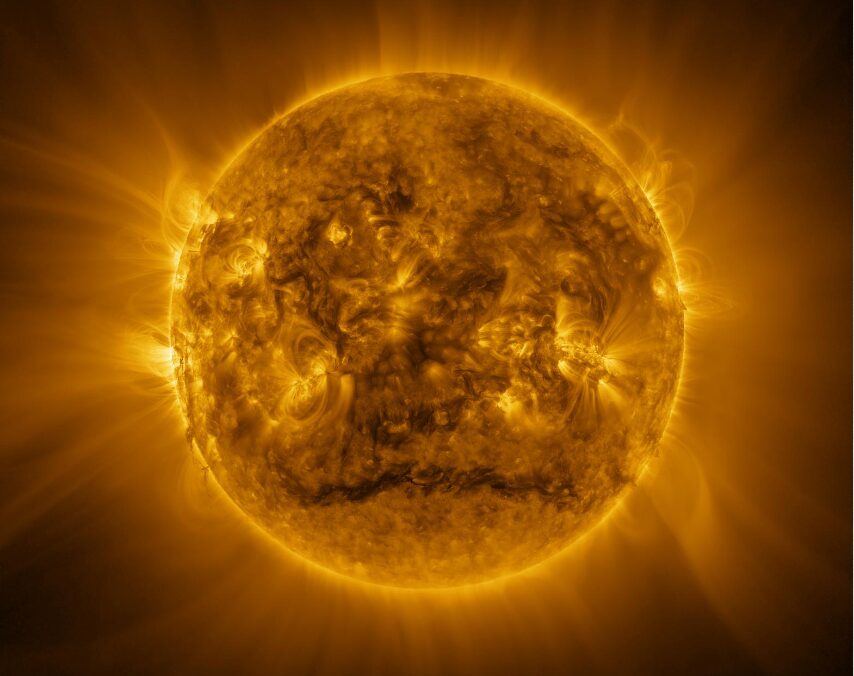🌌 NASA Confirms The New Giant Exoplanet Around a Tiny Star — And It’s Rewriting Planet Formation Theories
“The new exoplanet found by a team of astronomers in 2025 is a giant planet orbiting a tiny red dwarf star — one of the smallest stars ever known to host such a large planet.”
| Property | Details |
|---|---|
| 🌍 Planet Name | TOI-6894 b |
| 🪐 Planet Type | Gas Giant |
| 📅 Discovery Date | 2025 |
| 🔭 Discovery Method | Transit |
| 🧪 Planet Mass | 0.168 Jupiters |
| 📏 Planet Radius | 0.855 × Jupiter |
| 🔄 Orbital Period | 3.4 days |
| ☀️ Orbital Radius | 0.02604 AU |
| 🌀 Eccentricity | 0.03 |
| 🌟 Host Star Type | M-dwarf (0.2 × Sun’s Mass) |
New Exoplanet Found in a rare binary star system has stunned NASA scientists. According to the official NASA report on TOI‑6894 b, this gas giant orbits a tiny red dwarf—a scenario thought impossible under standard planet formation models.
Here are the 5 most shocking facts about this new exoplanet found in NASA’s binary star discovery:
🪐 1. New Exoplanet Found Around a Tiny Star — Defies All Odds
The newly discovered gas giant TOI-6894 b is orbiting a red dwarf with only 20% the mass of the Sun. Standard theories say stars this small shouldn’t have the right material to form such large planets — but here it is, rewriting the rules.. But NASA’s TESS mission spotted this gas giant orbiting surprisingly close to just one of the stars, defying all planetary formation models.
Internal Link: Read more about how binary systems work in our article on Sun’s Mysterious South Pole.
🧬 2. This Discovery May Break Existing Planetary Formation Theories
One of the shocking facts about this discovery is how stable the planet’s orbit is, despite being in a gravitational tug-of-war between two stars. Traditional theories suggest such planets should have been flung out or absorbed.
- Astronomers speculate that this planet may have migrated from a different part of the system or formed after the stars settled into their orbits.
- This challenges long-held models used in studying our own Solar System.
The planet’s existence challenges the core-accretion theory, as a star with just ~0.2 M☉ shouldn’t host such a massive world. As detailed by Phys.org’s University of Warwick article, researchers now consider alternative models like gravitational disk instability.
🌍 Why This New Exoplanet Found Could Change the Search for Life
While TOI-6894 b is a gas giant and not habitable, the new exoplanet found proves that stable planets can form in unlikely systems. That means there could be more habitable worlds in places we used to ignore — including around small, dim stars
🧠 Internal Link: Want to know if we’re getting closer to life elsewhere? Check our blog: Did NASA Discover a Parallel Universe?
This expands the habitable zone concept to more than just single-star systems like our own. If planets can form in wild systems like this one, the possibility of alien life just got a boost.
TOI‑6894 b’s transit depth is over 17%, making it an ideal target for atmospheric study with JWST. The transit signature was first discussed in Reuters, which called it “a planet that shouldn’t exist
🔥 4. This Giant Exoplanet Is Incredibly Close to Its Tiny Star
The new exoplanet found, TOI-6894 b, orbits extremely close to its tiny host star — a cool red dwarf with just 20% the Sun’s mass. That places it in the category of warm gas giants, but unlike the usual “hot Jupiters,” this planet has a surprisingly low atmospheric temperature of just 420 K.
Why it’s weird:
- 🔥 The star is small, yet the planet is massive
- 🧲 This tight orbit exposes the planet to strong magnetic fields
- 🌫 Despite the proximity, it retains a thick, cold atmosphere
This challenges long-standing models that say low-mass stars don’t host gas giants at all — let alone this close.
Interestingly, our blog has covered other strange stellar events—like the unexpected solar changes during the Solar Storm 2025 event, which revealed how chaotic space environments can behave.
💥 5. NASA’s TESS Mission Delivers the Unexpected—Again
NASA’s Transiting Exoplanet Survey Satellite (TESS) has been scanning the sky since 2018 to detect exoplanets by watching for tiny dips in starlight. In 2025, one of those dips turned out to be TOI-6894 b — a planet that has stunned scientists.
In a single year, TESS has found over 50 planet candidates, but TOI-6894 b stands out for being a giant planet orbiting the lowest-mass star ever known to host one.
| 🌌 Typical Binary System Challenges | ✔️ TOI-6894 b’s Breakthroughs |
|---|---|
| Planets rarely survive stable orbits in binary systems | Maintains close and stable orbit |
| Disrupted disk makes planet formation difficult | Formed successfully despite binary chaos |
| Strong radiation from twin stars | Likely retains thick gaseous atmosphere |
| Misaligned orbits often eject planets | Thrives in unusual out-of-sync orbit |
The surprise discovery of this planet shows we may have vastly underestimated the number of gas giants around small stars. For further reading, check out the full Nature Astronomy release summarized by UCL News and our detailed analysis of controversial space phenomena.
🌟 Why This Exoplanet Matters for the Future of Astronomy?
The new exoplanet found in 2025 isn’t just a space curiosity — it’s a scientific breakthrough. Here’s why astronomers worldwide are calling it a game-changer:
✅ Inspires a New Generation of Planetary Formation Models
Traditional theories struggle to explain how such a large gas giant could form around such a small red dwarf. This forces scientists to rethink the basics of how planets grow.
✅ Expands the Hunt to Overlooked Star Systems
Until now, tiny stars like TOI-6894 were often skipped in gas giant surveys. This discovery proves they deserve attention — and could be hiding many more surprises.
✅ Reveals Gas Giants Can Survive in Harsh Environments
Orbiting close to its star, TOI-6894 b defies odds by surviving where we thought gas giants couldn’t exist.
✅ Could Help Identify Earth-Like Planets in Binary Star Systems
If such unusual planets exist in binary or low-mass systems, the door is now open for finding habitable Earth-like worlds where we once thought it impossible.
📊 Final Thoughts: This Discovery Changes the Game
The new exoplanet found in 2025 is more than just an unexpected find — it’s reshaping astronomy. It challenges current models, opens new frontiers for exploration, and may even shift where we look for habitable worlds in the universe.
👉 As scientists explore TOI-6894 b further, this could mark the beginning of a new era in exoplanet research — especially around smaller, dimmer, or double-star systems.




